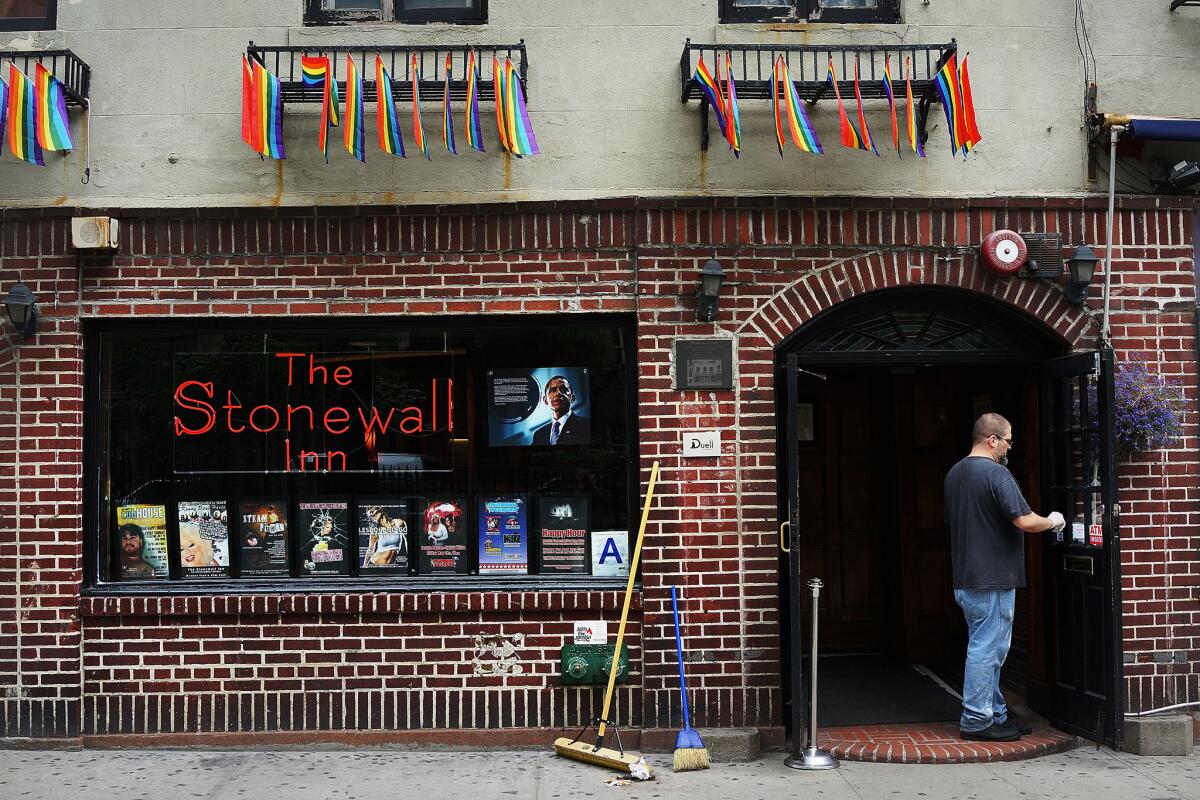New York’s Stonewall Inn, which sparked LGBT movement, designated as a landmark

The New York City Landmarks Preservation Commission has declared the Stonewall Inn a city landmark for its role in the fight for gay rights.
- Share via
Nearly 50 years after the Stonewall Inn riots set the stage for the modern gay-rights movement, the bar became a New York City landmark on Tuesday.
“The Stonewall Inn is a rarity – a tipping point in history where we know, with absolute clarity, that everything changed,” Manhattan Borough President Gale A. Brewer said in a statement. “This building has a unique place in the history of our city and in the struggle for dignity and equal rights in our society.”
The designation by the New York City Landmarks Preservation Commission means the bar cannot be torn down or developed without prior approval. No one opposed the designation, commission spokeswoman Damaris Olivo said.
The Stonewall Inn is important to many in New York City because of its significance to the push for Lesbian, Gay, Bisexual and Transgender rights.
“As the symbolic starting point of the LGBT rights movement, the Stonewall Inn represents what Selma represents for the civil rights movement, and what Seneca Falls represents for the women’s rights movement,” New York City Public Advocate Letitia James said in a statement.
Decades ago, bars were not allowed to serve alcohol to gays, and gays who danced together were arrested, according the Stonewall Inn’s website.
On June 28, 1969, police raided the Greenwich Village bar about 1 a.m. and started detaining people who had no identification, as well as anyone who appeared to be cross-dressing.
Some patrons were allowed to leave through the front door. Instead of fleeing, however, they congregated outside the bar and watched as police handcuffed and shoved people into patrol wagons.
The crowd threw bottles and bricks at police, setting off three nights of unrest. The incident is regarded as the first large protest of the LGBT rights movement.
The Stonewall Inn resistance inspired the first gay pride parades, which debuted in large cities including New York, Los Angeles, San Francisco and Chicago. LGBT activist groups sprang up in New York and across the U.S., and the fight against discrimination based on sexual orientation grew.
“This building is a symbol of a time when LGBT New Yorkers took a stand and vowed that they would no longer live in the shadows, standing up for the equal rights of all New Yorkers,” Landmarks Preservation Commission Chair Meenakshi Srinivasan said in a statement.
The bar still showcases the same brick cladding and small storefront windows that serve as a backdrop in fading black-and-white photos of the ’69 riots. The arched entrances and the stuccoed walls of the upper floors haven’t changed either. The Stonewall Inn joins 32,743 other sites in New York City as protected landmarks.
To New York state Sen. Brad Hoylman and many others, the storefront that still reads “Stonewall Inn” in neon letters serves as a reminder of the hard-fought battle to end discrimination.
“When I think of Stonewall being preserved for future generations, I think of my 4-year-old daughter,” Hoylman said, “and I’m relieved to know that she’ll have access to the history that helped her dads build the family she grew up in.”
Twitter: @katemshepherd
More to Read
Sign up for Essential California
The most important California stories and recommendations in your inbox every morning.
You may occasionally receive promotional content from the Los Angeles Times.













